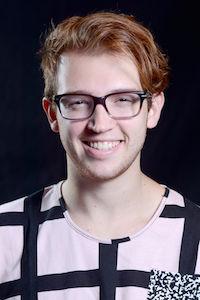
Nicky is a senior in psychology and women's and gender studies
Imagine a young man; let’s call him Arnie. When Arnie applies for colleges, he’s distraught. All of the applications provide “woman” as the only gender option. Some of them, when he’s lucky, offer “other” or “prefer not to disclose,” but these instances are few and far between. At any rate, he’s used to this kind of system, one that overlooks his gender identity.
Finally, Arnie’s accepted into a university. He had marked “other” on the application. For the most part, he feels at home on campus. Sometimes, though, when he takes tests that require filling out a Scantron, he again must choose between “female” and “other.” Though he feels it to be marginalizing, he usually opts for “other,” or leaves the gender category blank.
Around his campus, Arnie can only find bathrooms for women. He understands why there are no men’s rooms, seeing as men make up only a small percentage of the university’s population. But that doesn’t make the struggle of finding an appropriate bathroom any less difficult. Arnie considers himself lucky when he can find so much as a gender neutral, single-occupancy restroom.
The blatant fiction of Arnie’s life is, unfortunately, a reality for some. Such is the experience for those who identify as, and therefore are, gender queer — not belonging to either side of the male-female gender binary. Often, they report feeling uneasy when others refer to them as “he” or “she,” or as a “boy” or “girl.”
It’s time colleges and universities recognize this demographic. Until then, the exclusion of gender queer people marginalizes and makes these people invisible. To marginalize is to silence, to limit opportunities and to oppress.
Gender queer people, who fall under the “transgender” umbrella, may also refer to themselves as androgyne, non-binary or gender-fluid or by an array of other terms.
And the terms are vast. Most of them stem from the long-held scholarly belief that gender ought to be viewed on a spectrum rather than a binary. Some, such as “gray” or “neutrois,” refer to complete gender neutrality. Others, such as the terms “demigirl” and “demiguy,” capture an essence that is to say something like, “I am mostly a guy, but don’t completely align myself with traditional masculinity.”
Whatever a person’s preferred label, what it boils down to is simple: gender queer people feel — deeply and strongly — as though they do not fit neatly within the category of man or woman. An important side note: gender and sexuality are not the same thing; to identify as gender queer is not the same as to identify as gay, lesbian or bisexual, despite what the Tralfamadorians’ in Kurt Vonnegut’s “Slaughterhouse-Five” insistence that “homosexual men” is a sex would lead us to believe.
Though they comprise a small percentage of university demographics, with exact specifics unknown, it is high time colleges and universities — NC State included — recognized, at bare minimum, a third gender.
This is not unprecedented. The concept of a third gender is found in many cultures, such as the Native American’s concept of the “two-spirit” and Thailand’s “Kathoeys.” Likewise, other nations, such as Sweden and Nepal, have recently passed legislation that recognizes a third gender on the institutional level.
Online sites have taken to including various options that allow people to select gender identities other than man or woman. For instance, Facebook offers 56 options for its users, complete with pronoun selection. Likewise, OkCupid offers 22 gender types, as well as an array of varying sexualities.
Even in the United States, colleges and universities are making strides to recognize non-binary people. The University of Vermont has recently agreed to recognize a third gender, as well as the legitimacy of gender-neutral pronouns “they” and “their,” as The New York Times reported Tuesday. UVM now allows students, when enrolling, to provide their preferred name, regardless of legal standing, and pronouns. Faculty members receive this information so as to use the appropriate terms when interacting with gender queer students.
Certainly, it’s time for NC State to follow suit. In my experience, I have met plenty of people who would benefit in some way from the inclusion of a third gender option on applications and Scantron sheets or from labeling a few more (than the few in Harrelson Hall) on-campus restrooms as “gender neutral.”
Ideally, we could move from two genders to at least five. The five might include: man, woman, androgyne, gender-fluid and agender. However, given the slow pace at which things such as these move, maybe it’s best just to ask for a third option.
Though the demographic of gender queer people may be small, that does not render their existence any less valid than men’s and women’s. Even if they make up less than one percent of the population, as transgender people do, according to a 2011 review from the Williams Institute, it is still worth noting their existence. To deny them because they are few would be as ludicrous as to deny redheads or people who live in Wyoming who only account for .18 percent of the total US population.
Otherwise, we force them to assimilate, to pretend to be something other than themselves; we limit their right to express themselves and live as they wish.
The fight for the visibility of a third gender at the University of Vermont lasted a little more than a decade. Surely, other campuses will follow. If NC State hopes to keep up with the times, it’s best to get started now.